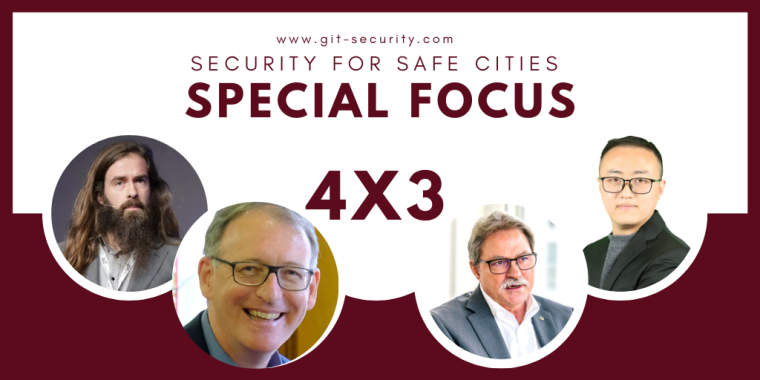Security for Safe Cities: Focus Interview
Four experts talk about approaches and solutions for a safer city.

1. What approach and solutions do you recommend to make our cities safer?
2. What are the biggest challenges in this field and how do you handle them?
3. Please describe a success case where you implemented your system in a ‘Safe City’ project?
Dieter Dallmeier Founder & CEO, Dallmeier electronic
1. As a manufacturer of video technology, we naturally concentrate on the area of video observation and video surveillance. We recommend the use of our patented “Panomera” multifocal sensor cameras. The special feature of these systems is that each camera combines up to eight lenses and video sensors of different focal lengths in one system. This technology is revolutionary, especially in the field of urban surveillance, as it enables the management of even the most complex situations in a safe manner, while making do with considerably fewer camera systems than all other solutions that rely on conventional video technology.
2. The great challenge for video security in public places is to maintain as good an overview as possible of large spatial contexts and at the same time to realise recordings that are as detailed as possible in “every corner” of the area to be secured and thus usable in court. With conventional camera technology, either one – a large overall view using megapixel cameras – or the other – detailed views using PTZ cameras – is possible. But there is no combination: if, for example, an operator zooms into a detailed area with a PTZ camera, the overall view is lost; when megapixel cameras are used, the resolution in detail is missing. With a multifocal camera, users combine the good overview of a megapixel camera with the possibility of theoretically opening any number of “virtual PTZs” at the click of a mouse.
3. In Germany alone, more than 30 large and very large cities now rely on Dallmeier security solutions. One of our first major projects was the “Cologne Cathedral Plateau”, a public square with approx. 8,800 square metres. After the sad events of New Year’s Eve 2015, where after riots over 1200 charges were brought only 37 convictions followed because the video images were unusable, the protection of the area was put out to tender again. Dallmeier won because our solution only required eight camera systems at two installation points -– achieving a resolution density of 250 pixels per metre or more across the entire area, the highest resolution quality according to DIN EN 62767-4 and the level that is typically considered “court-proof”.
Yavor Gueorguiev, Application Delivery Manager, Intelligent Mobility at Genetec EMEA
1. Despite increased investment in public safety technology, some agencies are still struggling to move safe city initiatives forward. Their challenges stem from two key trends: departmental siloes and data overload. As more devices are added to the city network, more agencies are inundated with data. Trying to make sense of the information not only slows emergency response but also limits cities’ ability to spot issues and make changes that can positively impact their communities.
Departments responsible for managing safe city projects are also known to work independently. This can often lead to redundant work and slower response times to incidents. Safe city initiatives can only succeed when data is consolidated and shared across departments. Increased collaboration creates opportunities to better serve the needs of the community.
2. To increase public safety, it is invaluable to invest in a unified security platform that consolidates data from numerous systems – such as IP video surveillance, access control and automatic number plate recognition – in a single interface. This unified vision helps to improve collaboration and reduce security risks in the city environment. With a unified platform, you can also plug in a digital evidence management system (DEMS) to speed up investigations. This platform enables Police to collect, manage, and share digital evidence from public and private networks with internal and external stakeholders. If set up correctly, it is a win-win for all parties. Citizens receive improved public safety, police forces benefit from time and cost efficiencies, and businesses can expect a faster response to incidents.
3. The Polish city of Lodz deployed our flagship unified platform, Security Center, to manage their camera network and reduce incidents of crime on its streets. A cutting-edge digital monitoring system was introduced, with additional cameras installed at junctions, parks, and squares to deter criminals and make citizens feel safe. Security Center allows operators in the city to access video footage from multiple systems and manage a coordinated response to incidents. The city of Lodz found that about 1,000 fewer crimes were reported to operators after only a year of moving to a unified solution. The platform was commended by the city for improving their public safety strategy, while also maintaining citizen privacy.
Werner Braun, Global Head of Portfolio Management Security at Siemens Smart Infrastructure
1. Our approach clearly focuses on the priorities of smart cities. These are, generally speaking, to protect people, businesses, and assets. In detail, it means to assure business continuity, namely, to minimize disruption especially of critical infrastructure. We support our customers in complying with security policies, laws, and regulations. We care for sustainability and support the digital transformation.
A solution that puts all these aspects in the center adds value to the attractiveness of a smart city. Our solutions hence focus on a completely digital platform that can empower cities with, for instance, the right situational awareness that can not only connect to the main safety and security systems in the field, but also be an open platform by design to integrate other data sources. Another feature is to allow for data insights based on the data gathered from various sources. Fast and smart responses to and resolution of incidents as well as proactive planning of activities to avoid incidents is another crucial aspect.
2. The biggest challenge is not only the tremendous numbers of connected data points and incidents that smart cities typically need to deal with, but also the requirement that numerous different security subsystems need to be interconnected. Additionally, the digital platform and, respectively, the security management system (SMS) must be able to integrate into proven technologies and new innovations alike. Therefore, it is key to have a SMS with a modern, multi-layer software architecture in place which is easily scalable and allows for rapid adaptation to the number of signals to be processed. Leveraging data to gain actionable insights and react appropriately is key. The system must be flexible enough to respond to customer-specific requirements and offer an open architecture allowing the integration of existing components and future services.
3. Expo 2020 Dubai was the Arab world’s largest event ever and was built like a city of the future. It hosted more than 200 participants, attracting over 24 million visitors from more than 190 countries. Siemens has been responsible for all security systems at the Expo 2020 site, which is roughly twice the size of Monaco, with more than 80 interfaces, 17,500 connected surveillance cameras, 3,500 doors, 200,000 data points, 100 operators in 9 distributed control rooms and 800 mobile security guards.
However, the security solutions from Siemens were not only designed to meet event-specific requirements. They are now being repurposed to support Expo 2020’s legacy project, the human-centric smart community of District 2020, an innovation-driven ecosystem and mixed-use development area which has been in use in Dubai South since the World Expo closed its doors. It now serves as a blueprint of future safe cities.
Gaolong Lin, City Solution Manager at Hikvision
1. From our point of view, security aspects of a safe city cover three main areas, the first one is public security incidents caused by vandalism, theft, resulting in social safety concerns. Second, it is people’s travelling stress caused by road and traffic incidents, traffic disorders. Third, it’s city’s environmental governance issues caused by natural or environmental disasters, such as floods and fire. Hikvision’s safe city system covers all three aspects, providing end to end solutions to make our cities safer.
Accordingly, in terms of public security, the company provides full-dimensional perception technology that helps cover ciritical security areas, such as city plazas, intersections and parking facilities. For those kinds of scenarios, Hikvision’s PanoVu and TandemVu products provide wide coverage without blind spots, giving security operators complete situational awareness and details when they are needed. Security products with Hikvision’s DarkFighter technology helps capture superior colored images even at night. Those advanced security devices greatly help improving management efficiency.
In terms of traffic safety, Hikvision provides an overall traffic management solution, through vehicle driving behavior analysis and violation detection, to improve better traffic management, as well as road and driver‘s safety.
2. When public security and traffic incidents happen, the city management department often need to conduct case analysis and investigation by referring to the video, which is very time-consuming. Even security coverage is complete and intense in the city, it is still hard to do. Hikvision provides structured video based on AI technology, that is to say, the solution is able to analyse anomalies such as abnormal driving behaviors, for example using an illegal license plate or driving the wrong way. Through advanced video technology and system, city management can be greatly improved.
3. A recent case study is the municipality of Tres Cantos in Spain which has deployed an innovative smart city solution from Hikvision to speed up journey times and maximize road safety and security for residents, commuters and local businesses. With constant movement of people and vehicles in and out of Tres Cantos, the municipality needed smart city solutions that could monitor traffic conditions in real time – enabling ‘re-routing’ and rapid incident responses to minimize congestion.
The Hikvision solution incorporates a total of 23 cameras located at the entrances to the municipality – including PTZ, PanoVu cameras, and ANPR cameras that provide situational awareness of traffic conditions. Real-time traffic and vehicle information, such as the flow of traffic and car accidents, can be aggregated and dynamically displayed in a central control room. The system has been particularly useful in terms of reacting to planned and unplanned road and lane closures. In such cases, traffic can be rerouted quickly and effectively to minimize delays and other negative impacts for residents and commuters.














